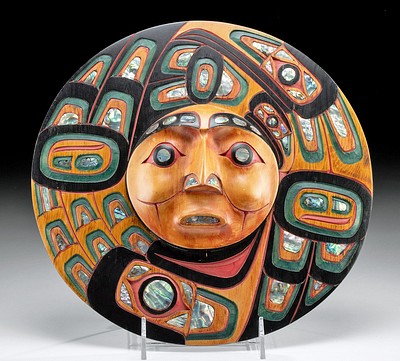Indian Mughal Gold Hair Ornament w/ Rubies, Emeralds
Lot 78
About Seller
Artemis Fine Arts
686 S Taylor Ave, Ste 106
Louisville, CO 80027
United States
Selling antiquities, ancient and ethnographic art online since 1993, Artemis Gallery specializes in Classical Antiquities (Egyptian, Greek, Roman, Near Eastern), Asian, Pre-Columbian, African / Tribal / Oceanographic art. Our extensive inventory includes pottery, stone, metal, wood, glass and textil...Read more
Categories
Estimate:
$1,500 - $2,000
Absentee vs Live bid
Two ways to bid:
- Leave a max absentee bid and the platform will bid on your behalf up to your maximum bid during the live auction.
- Bid live during the auction and your bids will be submitted real-time to the auctioneer.
Bid Increments
| Price | Bid Increment |
|---|---|
| $0 | $25 |
| $300 | $50 |
| $1,000 | $100 |
| $2,000 | $250 |
| $5,000 | $500 |
| $10,000 | $1,000 |
| $20,000 | $2,500 |
| $50,000 | $5,000 |
| $100,000 | $10,000 |
| $200,000 | $20,000 |
About Auction
By Artemis Fine Arts
Dec 7, 2023
Set Reminder
2023-12-07 10:00:00
2023-12-07 10:00:00
America/New_York
Bidsquare
Bidsquare : Fine Antiquities, Ancient & Pre-Columbian Art
https://www.bidsquare.com/auctions/artemis-gallery/fine-antiquities-ancient-pre-columbian-art-14361
Classical antiquities, ancient, and ethnographic art from cultures encompassing the globe. Egyptian, Greek, Roman, Etruscan, Near Eastern, Asian, Pre-Columbian, Native American, African / Tribal, Oceanic, Spanish Colonial, Fine / Visual Arts, so much more! Artemis Fine Arts info@artemisfinearts.com
Classical antiquities, ancient, and ethnographic art from cultures encompassing the globe. Egyptian, Greek, Roman, Etruscan, Near Eastern, Asian, Pre-Columbian, Native American, African / Tribal, Oceanic, Spanish Colonial, Fine / Visual Arts, so much more! Artemis Fine Arts info@artemisfinearts.com
- Lot Description
South Asia, Northwestern India, Mughal Empire, ca. 19th century CE. A stunning bell-shaped hair ornament made of high-quality gold that is filled with lac resin and inlaid with polki cut green emeralds and rubies- 5 emeralds and over 50 rubies! The gems are set in kundun gold- a technique that involves mounting the stone in and on gold foil to intensify their color. Hair ornaments such as this were worn by brides as decorative adornments and status symbols. The amazing craftmanship of this piece is a combination of Iranian Islamic and Indian Hindu artistic practices that came together under the Mughal empire. Mughal elites adored precious stones, not just for their beauty, but also for protective and magical properties that they believed each stone possessed. Size: 1.3" Diameter x 1.25" H (3.3 cm x 3.2 cm); gold quality: 89.12% to 98.1% (equivalent to 21 K + to 23K+); weight: 29.4 grams
Hair ornaments were and still are, essential accessories for Indian brides, their hair often plainted into braids that resembled snakes. The serpent symbolism was through to promote fertility and power. The segmented jewlery word along the braid has many names, but "jadai nagam or "jadanagam" translates to "snake braid." The braid also symbolized the Triveni Sangam, the confluence of the Ganges, Yamuna, and the mythic Saraswati rivers. At the tip of the braid were often these bell shaped pieces - sometimes strung with pearls or colored tassels.
When the Mughals conquered India from Central Asia, they brought the technical skills of setting gems and incorporated the traditional Indian styles of goldwork - including Kundan - into their jewelry that contained Middle Eastern elements - such as intricate floral patterns and heavy stonework, as seen here. Kundan stones (Kundan meaning "highly refined gold") is the traditional North Indian Rajasthan way of setting gemstones in a gold foil between the other stones, and the pure molten gold helped achieve the tight setting. Jewelry was a crucial part of visual authority for Mughal rulers, and strategic marriages between Mughal royalty and members of Rajput aristocracy were often arranged - for both political reasons and Rajasthan's renowned jewelry production. In order to enforce their high social status, the Mughals passed Sumptuary Laws that decreed only members of the upper class could wear opulent jewelry.
Provenance: private Boynton Beach, Florida, USA collection; ex-Rajiv Mehra collection, Delhi, India
All items legal to buy/sell under U.S. Statute covering cultural patrimony Code 2600, CHAPTER 14, and are guaranteed to be as described or your money back.
A Certificate of Authenticity will accompany all winning bids.
We ship worldwide and handle all shipping in-house for your convenience.
#177541Missing one emerald. Nicks and abrasiosn fissures on gemstones. Minor dark patina and toning to gold. Overall great condition.Condition
- Shipping Info
-
All shipping is handled in-house for your convenience. Your invoice from Artemis Gallery will include shipping calculation instructions. If in doubt, please inquire BEFORE bidding for estimated shipping costs for individual items.
-
- Buyer's Premium



 EUR
EUR CAD
CAD AUD
AUD GBP
GBP MXN
MXN HKD
HKD CNY
CNY MYR
MYR SEK
SEK SGD
SGD CHF
CHF THB
THB














